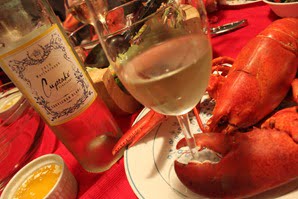How to Evaluate a Food and Wine Pairing.
June 1, 2011I think it should go without saying that everyone has a lifetime worth of experiences and knowledge relating to food tastes and characteristics; but most of us don’t necessarily pair wine with meals on a daily basis.
As a result, it could be stated that the general population lacks a decent ability to match appropriate wines with particular foods. Because of this, we generally have a shortage of good advice that people can use in everyday situations. In reality, there are very few wine choices that will totally ruin a meal, but good choices can raise the experience of a meal from enjoyable to memorable.
It’s a given that wine accompanies food, and food is always constantly looking for the perfect wine match. However, to fully understand the term ‘to accompany’, we must realize that this is the perfect "coming together” of both elements, where one does not mask the other, but where there is the best possible representation and expression of both. Synergy if you will!
It’s important to remember, there are no perfect food and wine pairings that everyone will love!
An example of a simply awesome pairing would be the marriage of Sauvignon Blanc from the Sancerre region of France, with salty  raw oysters. But this doesn’t work if you have someone that doesn’t care for oysters, or Sauvignon Blanc for that matter!
raw oysters. But this doesn’t work if you have someone that doesn’t care for oysters, or Sauvignon Blanc for that matter!
A lot of people use the idea of “…forget convention!!! If you want to pair red wine with fish, then you go right on ahead”.
I can agree with this up-to a point, however once you have experienced a perfect wine pairing, it may cause you to rethink that statement.
With the food and wine pairings that I have been running on this website, I thought it was worth a little insight into the framework that I use to assess the outcome of the wine pairing itself. It’s my slight attempt at making this whole thing that ever so slightly “academic”!
I’ve tried to simplify it as much as possible, in order to make it something you can use yourself, either in your own home or out to eat at a restaurant.
 Bad Match
Bad Match
The interaction of wine and food when tasted together has a negative impact on the senses. This is common when the food item is high in acidity, salt, bitterness, or spiciness.
A great example would be a Indian curry paired with a Cabernet Sauvignon. The curry is spicy; the wine is astringent, bold and would have a fairly high alcohol. The spiciness of the curry will create a sharp and unpleasant taste, and you’ll probably feel like your mouth is on fire from the alcohol!
 Refreshment
Refreshment
Many times wine serves simply as a satisfying refreshment to accompany a certain food choice. The refreshment match may be appropriate when the food choice inhibits a good or “perfect” wine choice.
For example, just recently I was eating chicken wings with a hot sauce. We had no beer in the house, so I selected a German Riesling in order to create a refreshing backdrop. There was no better wine option, at least in my opinion…
These pairing situations are average and pleasant, but are missing an element of individuality and thus cannot provide that amazing pairing that we are seeking.
A good example of a neutral match could be created by serving a large production, grocery store Chardonnay with Thanksgiving dinner. So many flavors, so many textures, but it would be difficult to come up with a much better match bearing in mind each individual component.
In this situation, you have found a wine that matches the food item’s basic components and overall body. The difference between a good match and a perfect one is that in the good match, the flavors don’t match 100%.
An example would be a Dry German Riesling served with baked or sautéed white fish. Riesling is one of my most food friendly wines. Served with the fish, it creates a good, or even very good match. However, to kick this pairing up a notch, the addition of herbs such as thyme or basil, or serving the fish lightly smoked would also add some great contrasts in flavors.
This essentially means the combined effect of the wine and the food when paired together is superior to the sum of the individual parts.
In terms of food and-wine pairing choice, a perfect match is obviously the ultimate objective! Check out my previous articles on Food and Wine Pairing to see some examples of a Perfect Match.
The main thing to remember is that no one person can be an authority with complete knowledge in wine and food pairing. Even so, understanding the basics of wine and food pairing can provide everyone with a better dining experience. My best piece of advice is trial and error!
This wine pairing guide has been based and adapted from the framework developed by Robert J. Harrington in his book, “Food and Wine Pairing: A Sensory Experience”
This entry was posted in News, Pairings and tagged Food, Pairing. Bookmark the permalink. ← This Week In Wine – May 28th 2011 How to Open a Bottle of Wine, Courtesy of Basil Fawlty →













